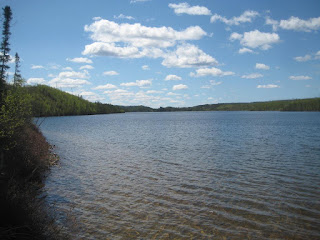June 10 at 4 a.m. as I break Camp 2, finally getting a photo of the snowshoe hare that loves my urine. I usually dump the pee bottle farther away, but I had done so from the nylon tent during the first night when the container was full.
It starts to rain, but I pack anyway, fingers crossed. There is a bit more rain as I canoe towards the next portage.
It starts to rain, but I pack anyway, fingers crossed. There is a bit more rain as I canoe towards the next portage.
When I ascend the creek near the portage, a bald eagle flies off from the shore. Then a large gull swoops down near the same spot. Curious, I walk through the brush to see that the eagle had caught a large whitefish and was eating it on shore. The gull now claims the meal but another gull lands nearby and there is a squabbling discussion about who gets dibs on the fish.
Interestingly, moving the canoe up the creek fully loaded is easier than the previous day when the canoe was relatively empty and the current turned it. There was some stiff poling but I manage okay.
At the upper end of the 90 metre portage to 'unnamed lake 1', a smoky fire helps shoo the bothersome blackflies while I load the canoe. It can be tempting to leave the load open, but covering today proves fortuitous.
Looking back at the just portaged creek. It feels good to be over the first major portage of the trip and away from direct road access.
Soon there is a short creek to move up, an easy paddle.
Rainfall starts as I canoe up the next lake ('unnamed lake 2'). Stopping at a winter trapping cabin for possible shelter, I soon move on because it is obviously very popular with black bears.
I don rain jacket and once in the canoe, I pull the tarp cover back to cover me below the waist. It continues to pour for the one km to a promising green peninsula that escaped the 2010 forest fire. Lighter green tops of jack pines amongst mostly black spruce is a sign of drier high ground. With no end in sight to the torrential rain, I decide to investigate the peninsula, hoping to land at a better spot than the near side which is muskeg with thick brush along shore. Canoeing past the point, the other side is more promising, one good spot where otters go up on their playground on the slope. The peninsula rises about 10 metres above the lake. Landing, my jeans soon get soaked by the wet undergrowth of deep moss and Labrador tea. Tromping inland, there are deep moose tracks in the stair-step moss and winter droppings to indicate when they visited. The peninsula drops off to more muskeg on the inland side, which explains why it was spared fire. There is a promising campsite overlooking the inland muskeg, but on walking back towards my landing I find I had already crossed a better site, higher and drier closer to the canoe. So the plan is made. Still raining! From the canoe up the slope there is a game trail through small and medium-size spruce trees to a level spot, which I clear and level for the canvas Tent. I cut out the thick sweet gale brush at shore which will cause me to trip while unloading the canoe if left as is. Impossible to cut brush with saw or axe, thank goodness for the pruners. It is 10:15 a.m. when I start the SPOT™ Satellite Messenger on the Tent site to let my contacts know I am okay and my location, an early stop but I am not a fan of travelling wet. As I unload the canoe I find it has several litres of rain water inside. After felling poles, I put up canvas Tent and stove and saw stovewood to boil water and make supper. Many bothersome mosquitoes in Tent, even with a cold north wind. With mosquito coil burning for 30 minutes in closed Tent, I saw more stovewood outside and erect tarp shelter. To bed by 8:30 p.m. after a hot water wash, burning quite a lot of stovewood overnight.
June 11, photos of Camp 3 in nice weather, five km from Camp 2 including the 90 metre portage. A robin sings long and splendidly last evening and first thing this morning. The day starts at 5℃ but by 9 a.m. the mosquitoes are quite bothersome as temperature later rises to 17℃. Letting the stove die, I close the Tent and light a mosquito coil. Blackflies are very bothersome so I dig a firepit under the moss and start a fire . A glorious but very cold bath washes away sweat helping to deter blackflies. I use the closed Tent all day for a bug free location for all three meals. In the absence of the bug tent I use the nylon tent or the canvas Tent quite often for meals when bugs are bad.
After supper, I prepack planning to move on tomorrow, weather permitting. Note that I have learned my lesson, I do not pack the stove or remove stovewood from Tent, leaving that to do in the morning when breaking camp. (I did remove the stovepipes in order to seal the stovepipe port against mosquitoes.)
After supper, I prepack planning to move on tomorrow, weather permitting. Note that I have learned my lesson, I do not pack the stove or remove stovewood from Tent, leaving that to do in the morning when breaking camp. (I did remove the stovepipes in order to seal the stovepipe port against mosquitoes.)
June 11, 4 a.m.
June 11, 12 noon.
June 11, 4:30 p.m.
















